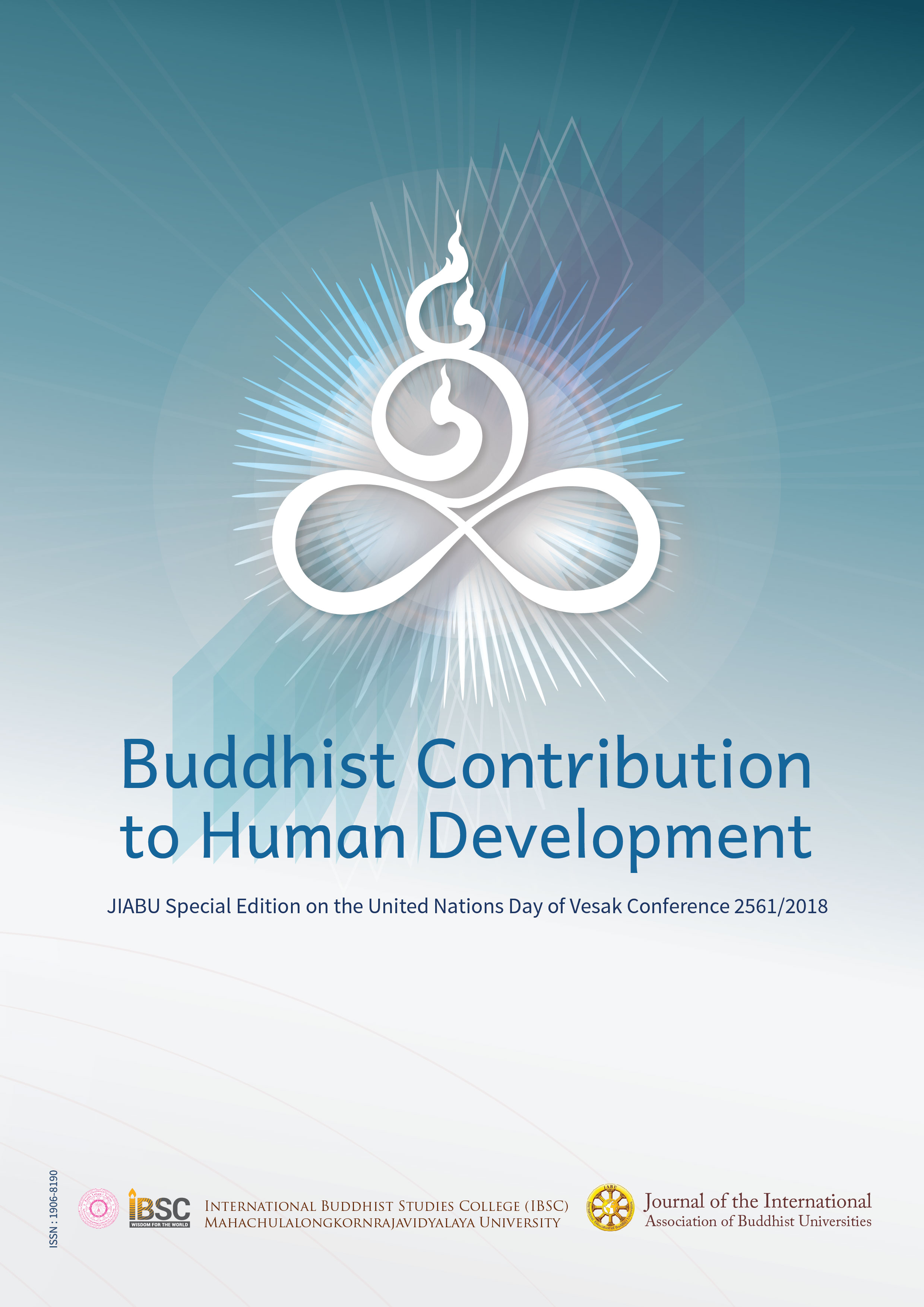A Critical Theory-Praxis for Contemplative Studies
Main Article Content
Abstract
Faith has an important role in early Theravāda Buddhism. The Theravāda Pali
Canon lists faith as one of seven treasures (dhāna), one of five spiritual faculties (indriyas),
and one of the spiritual powers (balas). There are also other lists of virtues in which faith
is included; faith is described as an important quality in some stream-enterers, a state
preceding enlightenment. In standard descriptions of people going forth (taking ordination
as a monk), faith is usually mentioned as an important motivation. Faith in the sense of a
trustful confidence – a quality more of the heart than a cognitive belief – has an important
role in Buddhism, albeit generally not as central as in some religions. Faith both leads to
calm and encourages one to seek to attain the stages of spiritual perfection. This paper
aims to search for current problems on Faith to the Saṅgha Community, to analyze their
cause and effects.
Article Details
Views and opinions expressed in the articles published by The Journal of the International Association of Buddhist Universities (JIABU), are of responsibility by such authors but not the editors and do not necessarily reflect those of the editors.
References
with Psychoanalyst Barry Magid.” mattbieber.net. March 3, 2014, http://www.
mattbieber.net/magid/.
Davis, Jake H., and David R. Vago. “Can Enlightenment Be Traced to Specifi c Neural
Correlates, Cognition, or Behavior? No, and (a Qualified) Yes.” Frontiers in
Psychology 4 (2013): 870. doi:10.3389/fpsyg.2013.00870.
Dennett, Daniel C.. Intuition Pumps and Other Tools for Thinking. New York: W.W.
Norton & Company, 2014.
Desbordes, Gaëlle, Tim Gard, Elizabeth A. Hoge, Britta K. Hölzel, Catherine Kerr, Sara
W. Lazar, Andrew Olendzki, and David R. Vago. “Moving Beyond Mindfulness:
Defi ning Equanimity as an Outcome Measure in Meditation and Contemplative
Research.” Mindfulness (January 21, 2014): 1–17. doi:10.1007/s12671-013-
0269-8.
Feit, Sean. “Mindfulness the Google Way: Well-intentioned Saffron-washing?” nadalila.
org. February 22, 2014. http://www.nadalila.org/mindfulness-the-google-way-wellintentioned-saffron-washing/.
Fideler, David. “Putting the World Back Together: The Future of Education and the Search
for an Integrated Worldview.” The Cosmopolis Project. Accessed April 28, 2015.
http://www.cosmopolisproject.org/2015/01/07/putting-the-world-back-together-thefuture-of-education-and-the-search-for-an-integrated-worldview/.
Frank, Adam. “Dreaming in Code: Michio Kaku’s ‘Future of the Mind.’” The New York
Times, March 7, 2014. http://www.nytimes.com/2014/03/09/books/review/michiokakus-future-of-the-mind.html.
Freud, Sigmund. Civilization and Its Discontents. Buckinghamshire, England: Chrysoma
Associates Ltd, 2000-2005 [1929].
Heuman, Linda. “A New Way Forward.” Tricycle, Spring 2015. http://www.tricycle.com/
feature/new-way-forward.
Horkheimer, Max, and Adorno, Theodor W. Dialectic of Enlightenment: Philosophical
Fragments, Edited by Gunzelin Schmid Noerr. Translated by Edmund Jephcott.
Stanford, CA: Stanford University Press, 2002.
Horkheimer, Max. “Traditional and Critical Theory.” In Critical Sociology: Selected Readings.
Edited by Paul Connerton. Harmondsworth: Penguin, [1937] 1976.
Horkheimer, Max. Between Philosophy and Social Science Selected Early Writings Studies
in Contemporary German Social Thought. Translated by G. Frederick Hunter,
Matthew S. Kramer, and John Torpey. Cambridge, MA MIT Press, 1993.
Jay, Martin. The Dialectical Imagination: A History of the Frankfurt School and the
Institute of Social Research, 1923-1950. Berkeley, CA: University of California
Press, 1973.
Kabat-Zinn, Jon. Coming to Our Senses. New York, NY: Hyperion, 2005.
Koenigsberg, Richard A.. “Analysis of Metaphor: Methodology for the Psychological
Interpretation of Culture.” Library of Social Science. Accessed April 28. 2015.
http://www.libraryofsocialscience.com/essays/koenigsberg-analysis-of-metaphor.
html.
Krystal, Arthur. “The Shrinking World of Ideas.” The Chronicle of Higher Education,
November 21, 2014. http://www.chronicle.com/article/The-Shrinking-World-ofIdeas/150141/.
Lindahl, Jared R.. “Why Right Mindfulness Might Not Be Right for Mindfulness.” Springer
Link, December 28, 2014. http://link.springer.com/article/10.1007/s12671-014-
0380-5/fulltext.html.
Marcuse, Herbert. One-Dimensional Man: Studies in the Ideology of Advanced Industrial
Society. New York, NY: Routledge, 1964.
Mendieta, Eduardo. “Religion as Critique: Theology as Social Critique and Enlightened
Reason,” in The Frankfurt School of Religion: Key Writings by the Major Thinkers,
edited by Eduardo Mendieta (New York, NY: Routledge, 2005).
Miller, James. “Turning Students into Citizens, Religious Studies Edition.” Religion
Dispatches, December 15, 2014. http://religiondispatches.org/turning-students-intocitizens-religious-studies-edition/.
Moloney, Paul. “Unhappiness is Inevitable.” The Guardian, August 27, 2006. http://www.
theguardian.com/commentisfree/2006/aug/28/comment.mainsection1.
North, Anna. “The Mindfulness Backlash.” The New York Times, June 30, 2014. HTTP://
op-talk.blogs.nytimes.com/2014/06/30/the-mindfulness-backlash/.
Piacenza, Joanna. “TIME’s Beautiful, White, Blonde ‘Mindfulness Revolution.’” Huffington
Post, January 29, 2014. http://www.huffingtonpost.com/joanna-piacenza/timemindfulness-revolution_b_4687696.html.
Poole, Steven. “The Wellness Syndrome by Carl Cederström and Andre Spicer- Exploitation
with a Smiley Face.” The Guardian, January 22, 2015. http://www.theguardian.com/
books/2015/jan/22/the-wellness-syndrome-carl-cederstrom-andre-spicer-persuasive diagnosis.
Purser, Ronald, and Andrew Cooper. “Mindfulness’ ‘Truthiness’ Problem: Sam Harris,
Science and the Truth about Buddhist Tradition.” Salon, December 6, 2014. http://
www.salon.com/2014/12/06/mindfulness_truthiness_problem_sam_harris_science_
and_the_truth_about_buddhist_tradition/.
Purser, Ronald, and Forbes, David. “Search Outside Yourself: Google Misses a Lesson in
Wisdom 101.” Huffington Post, March 5, 2014. http://www.huffingtonpost.com/
ron-purser/google-misses-a-lesson_b_4900285.html.
Singer, Tania, and Matthieu Ricard, eds. Caring Economics: Conversations on Altruism
and Compassion, Between Scientists, Economists, and the Dalai Lama. New York:
Macmillan, 2015.
Vago, D. R., and D.A. Silbersweig. “Self-awareness, Self-regulation, and Self-transcendence
(S-ART): A Framework for Understanding the Neurobiological Mechanisms of
Mindfulness.” Frontiers in Human Neuroscience 25, no. 6 (2012): 296. doi: 10.3389/
fnhum.2012.00296.http://www.ncbi.nlm.nih.gov/pubmed/23112770.
Vago, David. “What is Mindfulness?” Contemplative Mind in Life. Accessed April 28,
2015. https://contemplativemind.wordpress.com/what-is-mindfulness/.
Warren, Jeff. “Enlightenment’s Evil Twin.” Psychology Tomorrow, January 2014. http://
www.psychologytomorrowmagazine.com/enlightenments-evil-twin/.
Weisberg, Deena Skolnick, Frank C. Keil, Joshua Goodstein, Elizabeth Rawson, and Jeremy
R. Gray. “The Seductive Allure of Neuroscience Explanations.” Journal of Cognitive
Neuroscience 20, no. 3 (2008): 470–477. DOI: 10.1162/jocn.2008.20040, Http://
www.ncbi.nlm.nih.gov/pmc/articles/PMC2778755/.
Wylie, Mary Sykes. “How the Mindfulness Movement Went Mainstream - And the Backlash
That Came With It.” Alternet, January 29, 2015. http://www.alternet.org/personalhealth/how-mindfulness-movement-went-mainstream-and-backlash-came-it.


